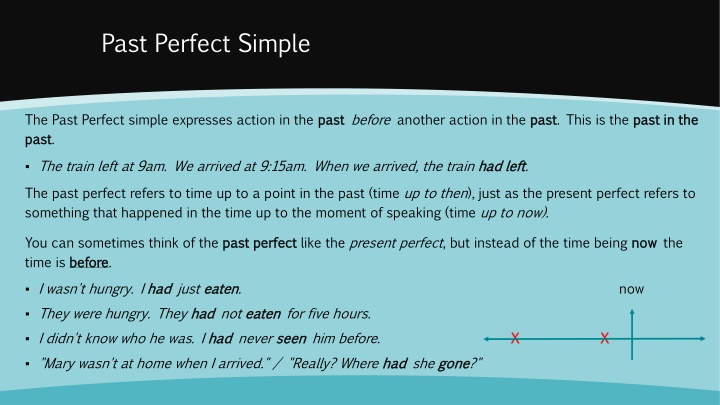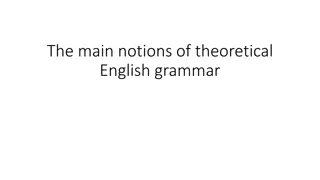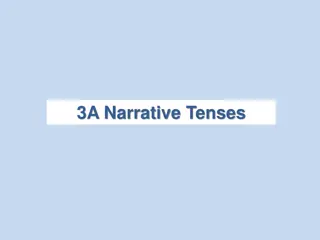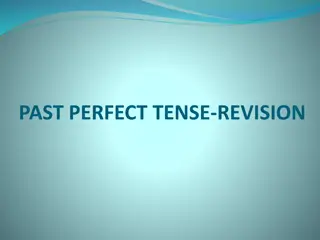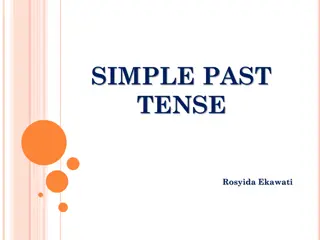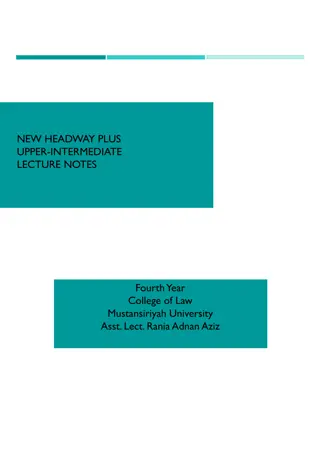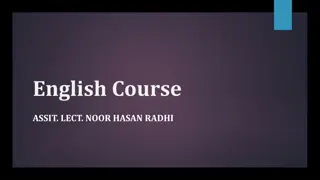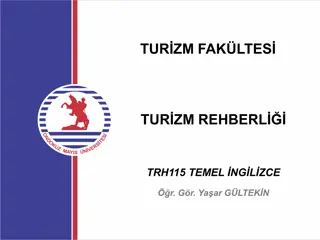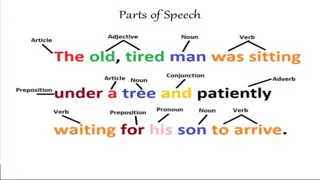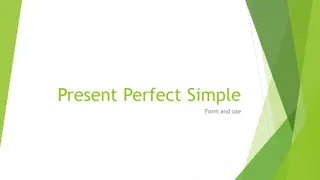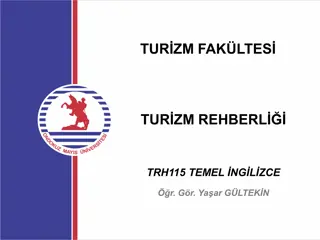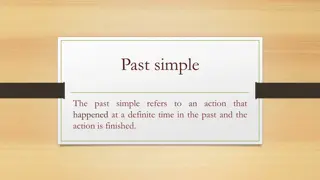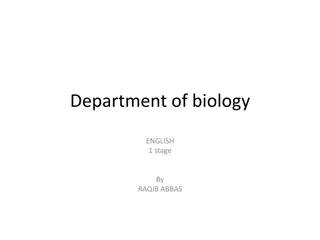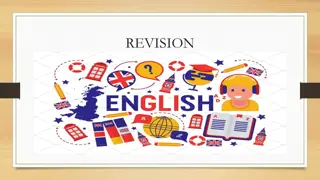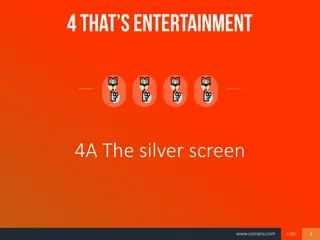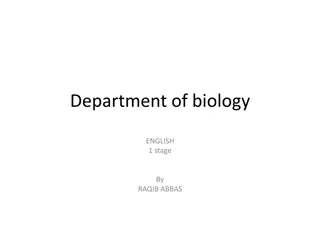Past Perfect Simple in Grammar
The Past Perfect Simple is used to express an action that occurred before another action in the past. With examples like "The train left at 9am," learn how to properly use this tense to convey past events accurately and effectively in your writing.
Download Presentation

Please find below an Image/Link to download the presentation.
The content on the website is provided AS IS for your information and personal use only. It may not be sold, licensed, or shared on other websites without obtaining consent from the author.If you encounter any issues during the download, it is possible that the publisher has removed the file from their server.
You are allowed to download the files provided on this website for personal or commercial use, subject to the condition that they are used lawfully. All files are the property of their respective owners.
The content on the website is provided AS IS for your information and personal use only. It may not be sold, licensed, or shared on other websites without obtaining consent from the author.
E N D
Presentation Transcript
Past Perfect Simple The Past Perfect simple expresses action in the past past past. past before another action in the past past. This is the past in the past in the The train left at 9am. We arrived at 9:15am. When we arrived, the train had left had left. The past perfect refers to time up to a point in the past (time up to then), just as the present perfect refers to something that happened in the time up to the moment of speaking (time up to now). You can sometimes think of the past perfect time is before before. past perfect like the present perfect, but instead of the time being now now the I wasn't hungry. I had had just eaten eaten. now They were hungry. They had had not eaten eaten for five hours. I didn't know who he was. I had had never seen seen him before. X X X X "Mary wasn't at home when I arrived." / "Really? Where had had she gone gone?"
Past Perfect Simple The past perfect is often used in reported speech after verbs like: said, told, asked, thought, wondered: He told us that the train had left I thought I had met had met her before, but I was wrong. He explained that he had closed had closed the window because of the rain. I wondered if I had been had been there before. I asked them why they had had not finished finished. had left. The past perfect is often found in more formal writing, such as fiction. The simple past can be used to say that a certain event happened, but then the fiction writer uses the past perfect to explain what had happened before that event: Billy felt great that evening. Earlier in the day, Annie had caught one fish, and he had caught three. They had had a delicious picnic near the lake and they had gone swimming again. It had been a nearly perfect vacation day.
Past Perfect Simple We often use the past perfect to refer to situations which have changed. In speaking, had is often stressed: Are you going anywhere today? I had planned to go to the beach but look at the rain! (had is stressed; the meaning is I have now changed my mind ). I m very happy working as an engineer but I had wanted to be an actor when I was younger.
Past Perfect Progressive Past Past Perfect Progressive Perfect Progressive WE HAD BEEN SINGING Auxiliary HAVE in past tense Auxiliary BE in past participle form Main verb SING in present participle form (-ing) SUBJECT
Past Perfect Progressive The past perfect progressive emphasizes the duration of an activity that was in progress before another activity or time in the past. This tense may also express an activity in progress close in time to another activity or time in the past. It also occurs in reported speech. This tense is used less frequently compared to other verb tenses. The Past Perfect progressive is like the past perfect tense, but it expresses longer actions in the past past before another action in the past past: John started waiting at 9am. I arrived at 11am. When I arrived, John had been waiting had been waiting for two hours. X X X X duration now
Past Perfect Progressive John was very tired. He had been running had been running. I could smell cigarettes. Somebody had been smoking had been smoking. Suddenly, my car broke down. I was not surprised. It had had not been running been running well for a long time. Had Had the pilot been drinking been drinking before the crash? For example, imagine that you meet Steve at 11:00 am. Steve says to you: "I m m angry. I ve been waiting ve been waiting for two hours Later, you tell your friends: Steve was was angry. He had been waiting had been waiting for two hours .
Exercises Make the past perfect simple: Make the past perfect simple: 1. When I arrived at the cinema, the film ____________________ (start). 2. She ____________________ (live) in China before she went to Thailand. 3. After they ____________________ (eat) the shellfish, they began to feel sick. 4. If you ____________________ (listen) to me, you would have got the job. 5. Julie didn t arrive until after I ____________________ (leave). 6. When we ____________________ (finish) dinner, we went out. 7. The garden was dead because it ____________________ (be) dry all summer. 8. He ____________________ (meet) her before somewhere. 9. We were late for the plane because we ____________________ (forgot) our passports. 10.She told me that she ____________________ (study) a lot before the exam.
Exercises 11. The grass was yellow because it ___________________ (not / rain) all summer. 12. The lights went off because we ___________________ (not / pay) the electricity bill. 13. The children ___________________ (not / do) their homework, so they were in trouble. 14. They ___________________ (not / eat) so we went to a restaurant. 15. We couldn t go into the concert because we ___________________ (not / bring) our tickets. 16. She said that she ___________________ (not / visit) the UK before. 17. Julie and Anne ___________________ (not / meet) before the party. 18. I ___________________ (not / have) breakfast when he arrived. 19. He ___________________ (not / use) email before, so I showed him how to use it. 20. You ___________________ (not / study) for the test, so you were very nervous.
Exercises The storm destroyed the sandcastle that we ________________ (build). He (not / be) ______________ to Cape Town before 1997. When she went out to play, she (do / already) ______________ her homework. My brother ate all of the cake that our mum _________________ (make) . The doctor took off the plaster that he (put on) _______________ six weeks before. The waiter brought a drink that I (not / order) ___________________ . I could not remember the poem we (learn) _________________ the week before. The children collected the chestnuts that (fall) ____________________ from the tree. (he / phone) ________________ Angie before he went to see her in London? She (not / ride) ________________ a horse before that day.
Exercises Make the past perfect progressive positive: Make the past perfect progressive positive: 1. 2. 3. 4. 5. 6. 7. 8. 9. 10. It _______________________________ (snow) for three days. I _______________________________ (work) all day, so I didn t want to go out. She _______________________________ (sleep) for ten hours when I woke her. They _______________________________ (live) in Beijing for three years when he lost his job. When we met, you _______________________________ (work) at that company for six months. We _______________________________ (eat) all day, so we felt a bit ill. He was red in the face because he _______________________________ (run). It _______________________________ (rain), and the road was covered in water. I was really tired because I _______________________________ (study). We _______________________________ (go) out for three years when we got married.
Exercises Make the past perfect progressive or the simple past: Make the past perfect progressive or the simple past: 1. 2. 3. 4. 5. I ________________________ (wait) for hours, so I was really glad when the bus finally ________________________ (arrive). Why ________________________ (be) the baby s face so dirty? He ________________________ (eat) chocolate. I ________________________ (see) John yesterday, but he ________________________ (run) so he was too tired to chat. It ________________________ (rain) and the pavement ________________________ (be) covered with puddles. When I ________________________ (arrive), it was clear that she ________________________ (work). There were papers all over the floor and books everywhere. They ________________________ (study) all day so, when we ________________________ (meet), they were exhausted. The boss ________________________ (talk) to clients on Skype for hours, so she ________________________ (want) a break. I ________________________ (drink) coffee all morning. By lunchtime, I ________________________ (feel) really strange. Lucy ________________________ (hope) for a new car, so she was delighted when she ________________________ (get) one. I ________________________ (dream) about a holiday in Greece! I couldn t believe it when my husband ________________________ (book) one as a surprise! 6. 7. 8. 9. 10.
New technology to help diagnose and manage respiratory diseases Monash University researchers in Australia have developed radical non-invasive technology that can be used to diagnose respiratory lung diseases, such as cystic fibrosis and lung cancer, and potentially fast-track treatments for patients. Researchers have for the first time taken technology usually confined to high-tech synchrotron facilities into a common laboratory setting, and applied new four-dimensional X-ray velocity (XV Technology) imaging to provide high-definition and sensitive real-time images of airflow through the lungs in live organisms. The study, led by Dr. Rhiannon Murrie from the Department of Mechanical and Aerospace Engineering at Monash University, shows the likely impact this technology has in respiratory disease detection, monitoring and treatment through non-invasive and non-terminal means. The technology also has the potential to see whether treatments for respiratory illnesses are working much earlier. The technology has since been commercialised by Australian-based med-tech company 4Dx Limited, led by CEO and former Monash University researcher Professor Andreas Fouras. The technology has been upscaled for human clinical trials taking place in the USA, with Phase I already completed successfully. The study was published in the internationally-renowned Nature Research Scientific Reports in January 2020. "The early diagnosis and ongoing monitoring of genetic and chronic lung diseases, such as cystic fibrosis, asthma and lung cancer, is currently hampered by the inability to capture the spatial distribution of lung function in a breathing lung," Dr. Murrie said.
Reading Since pulmonary function tests are measured at the mouth, these tests are unable to localise where in the lung any change in function originates. Additionally, CT scans, while providing quality 3D images, cannot image the lung while it is breathing, which means airflow through the airways and into the lung tissue cannot be measured . Research by Dr Murrie and the multi-disciplinary collaboration of physicists, engineers, biologists and clinicians are changing this approach to the diagnosis and treatment of lung diseases, by determining the functional lung movement and airflow in live mice, acquired through X-ray technology at 30 frames per second. A comparison of a cystic fibrosis mouse model against a healthy control mouse allowed researchers to observe a dramatic reduction in lung aeration in the left lung of the diseased mouse largely due to an obstructed airway path. Researchers were able to pinpoint the exact locations where lung deficiencies were present and the location of the obstruction causing the restricted airflow. The successful trial opens up avenues for respiratory diseases to be diagnosed, treated and managed earlier than current technology allows and at a lower radiation dose than current CT scanning. "The ability to perform this technique in the lab makes longitudinal studies on disease progression and treatment development feasible at readily accessible facilities across the world," Dr. Murrie said. "This finding is an exciting step in advancing the understanding of lung diseases and treatments that affect millions of people globally, and particularly for those with cystic fibrosis, which affects more than 70,000 people worldwide." Professor Fouras said: I am pleased to see this technology, originally developed at Monash University, and now being commercialised to maximise clinical impact, also enabling cutting-edge medical research like this .
